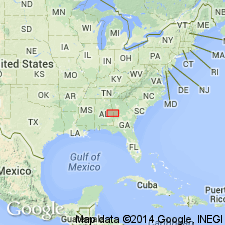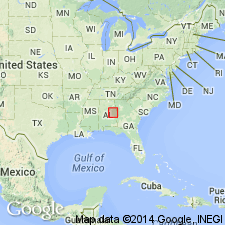
- Usage in publication:
-
- Roopville Formation
- Modifications:
-
- Named
- Dominant lithology:
-
- Schist
- Metagraywacke
- AAPG geologic province:
-
- Piedmont-Blue Ridge province
Summary:
Roopville Formation, named for exposures on GA Hwy 5 in Roopville, Carroll Co., GA, is credited to Bentley (in prep). [Report not published to date.] Roopville is the northernmost unit of the Heard Group and is described as an interlayered sequence of schist and metagraywacke. The schist is generally composed of fine to coarse-grained muscovite-feldspar and quartz. The metasubgraywackes are composed of muscovite-biotite-feldspar and quartz. Both lithologies locally contain small garnets. In some areas schist is the dominant lithology, in others it is metagraywacke. Roopville is characterized by a whitish, sandy, muscovite-rich soil over most of its outcrop area. Southward, in contact with the Glenloch Formation. Well exposed along U.S. Hwy 431, north of Roanoke, Randolph Co., AL. Generalized age of Precambrian to early Paleozoic shown on geologic map.
Source: GNU records (USGS DDS-6; Reston GNULEX).

- Usage in publication:
-
- Roopville Formation
- Modifications:
-
- Age modified
- AAPG geologic province:
-
- Piedmont-Blue Ridge province
Summary:
Age of the Roopville, according to the geochronoloy of G.S. Russell is Cambrian or older.
Source: GNU records (USGS DDS-6; Reston GNULEX).
For more information, please contact Nancy Stamm, Geologic Names Committee Secretary.
Asterisk (*) indicates published by U.S. Geological Survey authors.
"No current usage" (†) implies that a name has been abandoned or has fallen into disuse. Former usage and, if known, replacement name given in parentheses ( ).
Slash (/) indicates name conflicts with nomenclatural guidelines (CSN, 1933; ACSN, 1961, 1970; NACSN, 1983, 2005, 2021). May be explained within brackets ([ ]).

